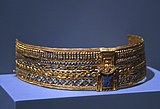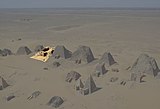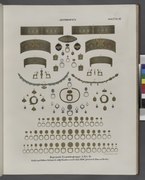Amanishakheto
| Amanishakheto | |
|---|---|
Meroe (Beg. N 6) | |
| Mother | Ar(...)tḫwit |
Amanishakheto was a queen regnant (kandake) of Kush who reigned in the early 1st century AD.[1] In Meroitic hieroglyphs her name is written "Amanikasheto" (Mniskhte or (Am)niskhete). In Meroitic cursive she is referred to as Amaniskheto qor kd(ke) which means Amanishakheto, Qore and Kandake ("Ruler and Queen").[2]
Amanishakheto is believed to have been the direct successor of the earlier queen regnant Amanirenas.[1][3] Amanishakheto's mother is recorded to have been named Ar(...)tḫwit; the relation between Amanishakheto and Amanirenas is thus unknown.[3] The chronologically next Kushite ruler, and thus Amanishakheto's possible successor, was another queen regnant, Shanakdakhete.[1]
Monuments
Amanishakheto is known from several monuments. She is mentioned in the
Amanishakheto is best known for a collection of jewellery stolen from her pyramid in 1834 by Italian treasure hunter Giuseppe Ferlini, who destroyed the pyramid in search of its burial goods.[4] It was a treasure that fulfilled all his expectations: it consisted of 10 bracelets, 9 shield rings, 67 signet rings, 2 bracelets and a large number of amulets, all created by the best craftsmen of the Kingdom of Meroë[5] These pieces are now in the Egyptian Museum of Berlin and in the Egyptian Museum of Munich.
Sandstone Relief
A sandstone relief depicting the queen, now at the Khartoum National Museum in Sudan, was found in the Temple of Amun in Naqa.[6] The relief depicts Queen Amanishakheto next to two deities. In Egyptian art, people depicted seated are of highest importance, followed by whoever is facing towards the right. It is also important to note the hierarchy of scale. In this depiction, Amanishakheto is taller than the two figures however, the god that is seated would be taller than the two women. The deities have been identified as Amesemi and Apedemak, the warrior god and goddess.[6] Amanishakheto is also seen wearing the royal costume that is associated with the Nubian warrior and hunting gods which further highlights her importance as a protector of her kingdom. The depiction of the queen with the two gods further emphasizes her power and status.
Stele of Queen Amanishakheto and the goddess Amesemi
The stele on the left is another representation of Amanishakheto accompanied by the warrior goddess, Amesemi. This stele is made from sandstone and was found in the Temple of Amun in Naqa.[7] The two women are depicted wearing similar garments: fitted clothing, a scarf with a tassel, a collar, and rounded wigs. Their bodies are represented in different ways however, the goddess has a slimmer figure with a dress that features more elaborate details. Amanishakheto is depicted in a more curvaceous way. The interaction between the two seems to be intimate, which also speaks to the power Queen Amanishakheto had. The hieroglyphs in the back of the stele identify both women.[8] This stele was placed in the Temple of Amun in Naqa, which was built after the death of Queen Amanishakheto.[7]
Gallery
-
Usekh collar of the queen
-
Bracelet from the tomb of Amanishakheto in Nubia
-
The Meroe pyramids. N6, the tomb of Amanishakheto, is highlighted
-
Some of the treasures stolen by Ferlini
See also
References
- ^ a b c Kuckertz, Josefine (2021). "Meroe and Egypt". UCLA Encyclopedia of Egyptology: 5, 16.
- ^ a b László Török, The kingdom of Kush: handbook of the Napatan-Meroitic Civilization
- ^ ISBN 82-91626-01-4.
- ^ Welsby, D. 1998: The kingdom of Kush: the Napatan and Meroitic empire. Princeton, NJ: Markus Wiener, pp. 86 and 185.
- ^ Vela-Rodrigo, Alberto A. (2021). "The sacred treasure of Queen Amanishakheto". Ancient Egypt Magazine. 21 (5): 44–50.
- ^ a b “Candace Amanishakheto of Meroe,” World History Encyclopedia, accessed April 28, 2021, https://www.worldhistory.org/image/8404/candace-amanishakheto-of-meroe/.
- ^ a b D. A. Welsby, Julie R. Anderson, and Dietrich Wildung, “Kushite Religion: Aspects of the Berlin Excavation at Naga,” in Sudan Ancient Treasures: an Exhibition of Recent Discoveries from the Sudan National Museum (London: The British Museum Press, 2004), pp. 174-182.
- ^ D. A. Welsby, Julie R. Anderson, and Dietrich Wildung, “Kushite Religion: Aspects of the Berlin Excavation at Naga,” in Sudan Ancient Treasures: an Exhibition of Recent Discoveries from the Sudan National Museum (London: The British Museum Press, 2004), pp. 181.
Further reading
- Laszlo Török, in: Fontes Historiae Nubiorum Vol. II, p. 723–725 (Bergen, 1996). ISBN 82-91626-01-4
- Török László, “The Kingdom of Kush: Handbook of the Napatan-Meroitic Civilization,” in The Kingdom of Kush: Handbook of the Napatan-Meroitic Civilization (New York: Brill, 1998), pp. 456.
- Vela-Rodrigo, Alberto A., in: The sacred treasure of Queen Amanishakheto, Ancient Egypt Magazine, 21(5), 2021, 44–50.
- P. L. Shinnie, Meroe: a Civilization of the Sudan, (Praeger, 1967),






